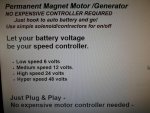Functional Artist
Well-known member
I am working on a Cart (El Dingo) with a Manta motor #5655 permanent magnet motor. (advertised as 10 HP / 8000 watts)
I made a simple (contact) controller based on a diagram in the ad I bought the motor from to control this motor. https://www.youtube.com/watch?v=c7q2Lq0P604
It bench tested great but, on the cart, under load, is a different story.
It works like a 3 speed stick shift transmission without a clutch. When driving the cart take off is abrupt and acceleration is good but, as accelerating going from 12 volts to 24 volts and then 36 volts is like driving an old hot rod with a racing shift kit, BANG 1st gear, BANG 2nd gear and BANG 3rd gear.
My main concern is when you decelerate it BANGS down reducing the motor speed abruptly. It seems to be very hard on the motor and cart and especially the chain (stretched on first test drive).
I would appreciate any thoughts or comments on controlling a "big" permanent magnet motor.
I made a simple (contact) controller based on a diagram in the ad I bought the motor from to control this motor. https://www.youtube.com/watch?v=c7q2Lq0P604
It bench tested great but, on the cart, under load, is a different story.
It works like a 3 speed stick shift transmission without a clutch. When driving the cart take off is abrupt and acceleration is good but, as accelerating going from 12 volts to 24 volts and then 36 volts is like driving an old hot rod with a racing shift kit, BANG 1st gear, BANG 2nd gear and BANG 3rd gear.
My main concern is when you decelerate it BANGS down reducing the motor speed abruptly. It seems to be very hard on the motor and cart and especially the chain (stretched on first test drive).
I would appreciate any thoughts or comments on controlling a "big" permanent magnet motor.



 that's ecxactly what I meant..
that's ecxactly what I meant..